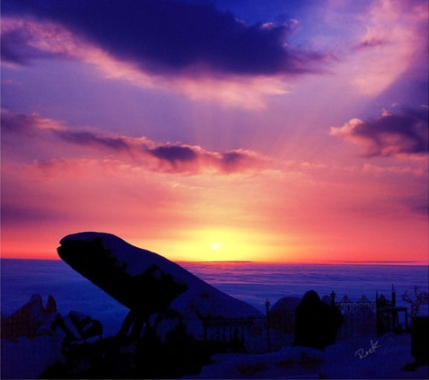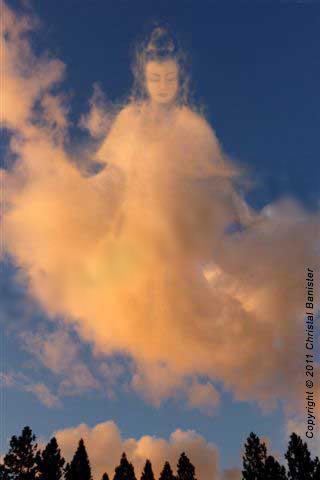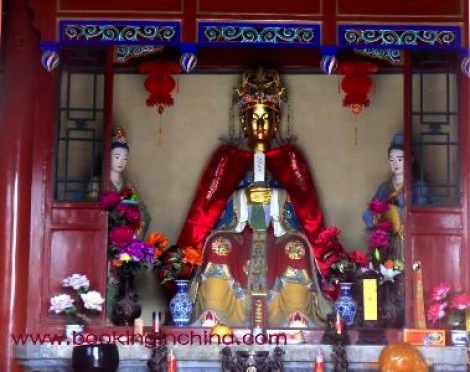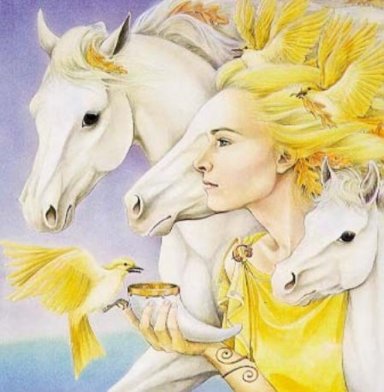 “Whale Goddess’ themes are nature, meditation, rebirth and movement. Her symbols are water and whales. In Arabic tradition, the Whale Goddess swallowed Jonah, giving him time to consider his life and actions, seriously before his figurative rebirth. Let’s hope She doesn’t have to got that far to get our attention this month (or anytime, for that matter).
“Whale Goddess’ themes are nature, meditation, rebirth and movement. Her symbols are water and whales. In Arabic tradition, the Whale Goddess swallowed Jonah, giving him time to consider his life and actions, seriously before his figurative rebirth. Let’s hope She doesn’t have to got that far to get our attention this month (or anytime, for that matter).
In some stories the earth rests on this Goddess’s back, and earthquakes result when She gets upset and shakes Her tail. Symbolically, when your life seems on shaky ground, consider what this Goddess is trying to tell you!
Around this time of year in Northern California, people examine the coastline with renewed interest and anticipation. They’re watching the annual whale migration – a breathtaking sight. Since many of us cannot experience this firsthand, consider the whale as a magical symbol instead. The gods ride whales to carry messages to the mortal world. Witches ride them to bear their magic on the water. In both instances the whale carries something – either to your heart or toward a goal. Use this image in meditations for movement, and consider if whales show up in your dreams tonight.
If possible, visit an aquarium and watch whale there. Or send a donation to an accredited facility to give something back to the Whale Goddess and Her children.”
(Patricia Telesco, “365 Goddess: a daily guide to the magic and inspiration of the goddess”.)
During my search on the World Wide Web, I couldn’t find any other information equating the whale in the Book of Jonah to an actual Goddess; however, the comparison is an intriguing theory to ponder on. So, I decided to focus on whale mythology from around the world:
SOUTH AMERICA
“Mamacocha
Goddess of the ocean, Her name literally means “mother ocean.” She is a source of health and provider of food. She is sometimes shown as a whale Goddess. To the Q’eros, many of whom will never even experience the ocean, She represents the largest expression of the living energy of water. Smaller water deities that inhabit lakes rivers and streams are known as Phasi Runa.” [1]
“CHINA
Yu-kiang
The ancient Chinese believed that a strange mythological figure, Yu-kiang, held sway over the sea. This dragon-riding water deity had the body of a fish but the hands and feet of a human being. It was not a true fish, however, but a kuan, a huge whale several thousand li long that came from the Northern Sea. Sometimes the monstrous kuan got angry, and when it did it turned into a gigantic bird (p’eng), whipping up terrible storms as it emerged aborve the ocean surface (M. Soymi, in P. Grimal, 1963)
ALASKA

"Sedna's Love" by Tammara
Sedna
In Inuit mythology, Sedna was the Goddess of the sea and the whale was her most magnificent subject. In one story, Sedna was a winsome girl who had spurned all of Her suitors and married a bird. Outraged, Her father killed Her husband and took Her home in a boat. On the way back he threw Her overboard. She clung to the umiak, so he had to chop off Her fingers, one by one.
Sedna turned into the huge voracious deity of the Lower World and ruled over all the creatures that dwell in the sea. Each of Her severed fingers turned into a different animal: a right whale, a narwhal, a beluga, a seal, and so forth.
Big Raven
The whale also appears in Inuit myths about the beginning of the world. One of the chief characters in their creation myths is Big Raven, a deity in human form. One day, Big Raven came upon a stranded whale and asked the Great Spirit to help him get the creature back out to sea. The Great Spirit told him of a place in the forest where moonlight fell a special way. There he would find mushrooms that, if eaten, would give him the strength to drag the whale into the water unassisted. Big Raven did as he was told, rescued the whale, and thereby safegarded the order of the world.
CANADA

"tlingit killer whale" by AhlanNatsihlane
Natsihlane
The Tlingit people of northern Canada tell the story of Natsihlane. Natsihlane was a good hunter, and his brother-in-law was jealous of him. One day, the two of them went ashore on a far distant land, but the brother-in-law went off and left him behind. Natsihlane fell asleep and was awakened by a big gull. He heard it say that the sea lion chief wished to see him and that he had been sent to fetch him. Knowing that there was strong medicine at work, Natsihlane climbed on the back of a sea lion that swam until it reached a great rock beside the cliff.
The rock opened, and the Tlingit hunter found himself inside a great house in which the sea lions were assembled.
‘This is my son,’ the chief of the sea lions said to him. ‘He has been wounded by a harpoon. Help him, and I will help you get back to your homeland.’ Natsihlane removed the harpoon and tended to his wounds. The chief thanked him and gave him a magic sea-lion stomach filled with air to use a boat.
When the hunter woke up on the beach, he heard an inner voice speaking to him. He went into the forest and carved eight big fish from spruce branches. He said some medicine words over them and ordered them to jump into the water. They sprang into the sea at his command, but lay lifeless on the surface. Natsihlane then cut eight more fish from the red cedar, but they would not live, either.
Then he carved eight fish from yellow cedar and painted each fish with a white stripe across the head and a circle on the dorsal fin. He sang his most powerful spirit song and commanded the fish to leap into the water. They did so and soon grew into great black whales. They obeyed his orders. He asked them to swim out and see to it that his brother-in-law was drowned. They did as he requested, after which he called them out of the water. They formed a line on the shore. ‘I made you to get revenge,’ he told them. ‘That was a bad thing to do. From now on, you must never again harm any human being.’
ICELAND
Heimskringla
‘The best-known whale in Icelandic legend is the one said in Snorri Surluson‘s ‘Heimskringla‘ to have been sent there by a Danish king, who was angry because the Icelanders had made libelous verse about him. He considered sending an army to Iceland, but first he sent a magician disguised as a whale to spy for him. The journey was fruitless because everywhere the magician he was frustrated by the country’s guardian spirits.’
According to another legend, ‘a man threw a stone at a fin whale and hit the blowhole, causing the whale to burst. This deed was condemed and the man was told not to go to sea for twenty years. In the nineteenth year he could no longer resist the desire to return to sea. He went fishing – and a whale came and killed him.’ Whales can forgive a crime, but only if it had been properly atoned for.
AFRICA
King Sulemani
In one East African legend a whale teaches a king a lesson in humility.
‘One day, when all the people, spirits and animals in his kingdom had eaten their fill, Sulemani prayed to God that He might permit him to feed all the created beings on earth … But God wished to show him that all human enterprise must have an end in the very size of the encounter it has sought so fervently to face. It pleased God to raise to the surface of the sea a fish such as fishermen had never seen. In the learned books it is described as a whale, but it was much bigger. It rose up from the water like an island, like a mountain. It ate and ate, until there was not a single bag of corn left. The whale raised its voice and roared: ‘Oh king, I am still hungry, Feed me!’ Sulemani asked the big fish if there were more fishes of its size in the sea, to which the sea-monster replied: ‘Of my tribe there are seventy thousand.’ At these words, King Sulemani prostrated himself upon the ground and prayed to God: ‘Forgive me, Lord, for my foolish desire to feed Thy creation.’ King Sulemani thanked the creature for teaching him a lesson. From then on, he no longer tried to take over God’s job of feeding all His creatures.” (translated from the Swahili by Jan Knapper)
THE BIBLE
Leviathan
It is clear that God invested the huge, monstrous whale with tremedous power, including the power to strike fear into the hearts and minds of men. Nowhere does the whale’s terrifying prescence inspire more lyricism and hyperbole than in the Holy Scriptures.
The first creature God releases into the waters is the whale. ‘And God said, Let the waters bring forth abundantly the moving creature that have life … And God created the great whales, and every living creature that moveth.’
The biblical whale par excellence is the stupendous Leviathan – symbol of evil, focal point of all human fears, embodiment of unmitigated power – that the Lord created on the fifth day of Creation as a warning to mankind. From then on ‘Leviathan maketh a path to shine after him,’ whenever pride and the temptation to sin well up in the sons of Adam. Its gaping mouth is terrible to behold; nothing can equal its strength; its heart harder than stone.
Leviathan is mentioned again in Fourth Esdras, a Jewish apocalyptic work usually included in the Apocrypha. ‘On the fifth day thou didst command the seventh part, where the water had been gathered together, to bring forth living creatures, birds, and fishes … Then thou didst keep in existance two living creatures; the name of one thou didst call Behemoth and the name of the other Leviathan … But to Leviathan thou didst give the seventh part, the watery part.’
 Jonah
Jonah
The biblical story of Jonah in the whale, begins when the Almightly instructs Jonah (from Hebrew for “dove”) to prophesy against the wickedness of the city of Nineveh. Fearing the reaction of the lewd, luxury-loving Assyrians, he balked at the mission, rushed to Joppa, and stole away on a boat bound for Tarhish. But he had spoken ill of the Lord and doubted his Infinite Wisdom, so he never reached his destination.
The ship ran into a terrific storm. Believing it to be a sign from the Almighty, the crew threw Jonah overboard at the prophet’s request. As the water swirled around him and death seemed at hand, Jonah asked God to have mercy on him. The Lord, hearing His name uttered in prayer, sent a Great Fish from the depths to swallow him. After three days and three nights the whale ‘vomited out Jonah upon dry land.’ The prophet had been taught a lesson in unconditional obedience.
EARLY STORIES
The Whale-Island

One of the favorite imaginings of whale chroniclers, was of the living island, the animal island, the whale-island. The notion of a sleeping whale, with its dark rocklike back, being mistaken for an uncharted island is as old as maritime literature itself.
An early reference of such an occurance, comes from the Physiologus (Greek, second century), a collection of anecdotes dealing mainly with natural history.
‘There is a certain whale in the sea called the aspidoceleon, that is exceedingly large like an island … Ignorant sailors tie thier ships to the beast as to an island and plant thier anchors and stakes in it. They light their cooking fires on the whale, but when it feels the heat it urinates and plunges into the depths, sinking all the ships.’
Sinbad
The whale is recounted in this episode of the voyages of Sinbad, translated from the Arabic by N. J. Dawood.
‘We came at length to a little island as fair as the Garden of Eden. The passengers went ashore and set to work to light a fire. Some busied themselves with cooking and washing, some fell to eating and drinking and making merry …
Whilst we were thus engaged we suddenly heard the captain cry out to us from the ship: ‘All aboard quickly! Abandon everything and run for your lives! The mercy of Allah be upon you, for this is no island but a giganitic whale floating on the bosom of the sea, on whose back the sands have settled and trees have grown since the world was young! When you lit the fire, it felt the heat and stirred. Make haste, I say, or soon the whale will plunge into the sea and you will all be lost!’
Some reached the ship in safety, but others did not; for suddenly the island shook beneath our feet and, submerged by mountainous waves, sank with all that stood upon it to the bottom of the roaring ocean.’
Pinocchio
One of the key episodes in The Adventures of Pinocchio, by Carlo Collodi (pseudonym of Carlo Lorenzini, 1826-90) takes place in the belly of a sea monster, a creature Collodi describes as a ‘gigantic Dog-fish,’ an Attila of fish and fishermen” that is ‘more than a kilometer long, not counting its tail.’ Readers soon realise that it must be a whale, as the creature breathes through its lungs … and suffers from asthma!
The Dog-fish ‘sucked Pinocchio in as he would have sucked a hen’s egg.’ When the marionette reaches the monster’s stomach, he meets up with a philosophical tuna that assures him, ‘When one is born a Tunny it is more dignified to die in the water than in oil.’ Then Pinocchio thinks he sees a light. It is the glow of a candle held by – can it be? – Gepetto, his father! the old carpenter had survived inside the whale ‘for almost two years,’ living on supplies from the ship the beast had inadvertently swallowed. Dragging, then carrying his father, Pinocchio makes his way to the tongue of the Dog-fish, which one would mistake for ‘a lane in the park.’ They manage to get past the giant fish’s ‘three rows of teeth’ because it ‘suffered very much from asthma’ and had to sleep with its mouth open.
Micromégas
In 1752, Voltaire (1694-1778) wrote Micromégas in which whales served as living proof of man’s colosal conceit. When Micromégas, the super-giant from Sirius, and an average-sized giant from Saturn reach Earth, they assume that a planet so ridiculously small could not possibly harbor living things. Then, using diamonds as magnifying glasses, they manage to spot a whale. Later, they have to squint and strain their eyes to make out a boatload of philosophers.
‘After a long time, the inhabitants of Saturn saw something almost imperceptable in the Baltic Sea: it was a whale. Very adroitly he picked it up with his little finger and, placing it on his thumbnail, showed it to the Sirian, who started laughing at the extreme smallness of the inhabitants of our globe. The Saturnian, satisfied that our world was inhabited after all, assumed immediately that all inhabitants were whales.'” [2]
Moby-Dick
Moby-Dick; or, The Whale is a novel by Herman Melville, first published in 1851. It is considered to be one of the Great American Novels and a treasure of world literature. The story tells the adventures of wandering sailor Ishmael, and his voyage on the whaleship Pequod, commanded by Captain Ahab. Ishmael soon learns that Ahab has one purpose on this voyage: to seek out a specific whale—Moby Dick, a ferocious, enigmatic white sperm whale. In a previous encounter, the whale destroyed Ahab’s boat and bit off his leg, which now drives Ahab to take revenge. [3]

"Whale Song" by Griffblut
As a totem, the whale can teach us a great deal about ourselves. “The Whale Totem symbolizes, the power of the Sea, deep intuition, ancient knowledge, strength and grace and mystical communication. Whales have been the inspiration of many songs, myths, books, poems, paintings, drawings and movies. The Whale is the worlds largest mammal they are very family orientated like their land counterpart the Elephant. Whales can be found in oceans all over the world. They belong to the same family as dolphins and porpoises and possess the same ability as their smaller cousins to communicate with each other through sounds, vibrations and songs.
The Exceptional Whale Totem possesses the following virtues:
Deeper consciousness, ancient energy and vibrations, family values, happiness and harmony, beauty, balance, beauty, social skills, increased powers of communication, affection, energy, grace, charm, charisma, and intelligence.
The Whale animal totem is a strong spirit indeed and its magical properties are one of the most influential of all animal totems. Strength, friendship, virtue, cooperation, and so much more can be integrated into the spirit of the possessor of this magical pearl and the Whale totem.” [4]
Please also check out Avia Venefica’s site, Whats-Your-Sign.com, “Whale Totem Meaning” for a fabulous in depth look at the whale as a totem.
Sources:
Goddess-Guide.com, “List of the Inka Goddesses”
HippyMom.com, “Whale Totem”
Wikipedia, “Moby-Dick”
World Transformation, “Whale Mythology From Around the World“
 “Bixia Yuanjun (Sovereign of the clouds of dawn) is a Daoist Goddess connected with Mt. Tai in Shandong province. As the easternmost of the five sacred peaks of China, Mt. Tai was considered the gateway to the afterlife throughout Chinese history. Bixia and Her main temple located there attained prominence in the early Ming dynasty (1368 – 1644). Centered in northern China, the Goddess’s popularity extened from the imperial family to common people. Bixia was granted elevated titles, such as Tianxian shengmu (Heavenly immortal, saintly mother) and Tianxian yünu (Hevenly immortal, jade maiden), but She is commonly known as Taishan niangniang (Our Lady of Mt. Tai) or Lao nainai (Granny) in Chinese popular religion. She was charged with setting human life spans and judging the dead, but Her ability to facilitate the birth of male children made Her a particularly popular Goddess among women.
“Bixia Yuanjun (Sovereign of the clouds of dawn) is a Daoist Goddess connected with Mt. Tai in Shandong province. As the easternmost of the five sacred peaks of China, Mt. Tai was considered the gateway to the afterlife throughout Chinese history. Bixia and Her main temple located there attained prominence in the early Ming dynasty (1368 – 1644). Centered in northern China, the Goddess’s popularity extened from the imperial family to common people. Bixia was granted elevated titles, such as Tianxian shengmu (Heavenly immortal, saintly mother) and Tianxian yünu (Hevenly immortal, jade maiden), but She is commonly known as Taishan niangniang (Our Lady of Mt. Tai) or Lao nainai (Granny) in Chinese popular religion. She was charged with setting human life spans and judging the dead, but Her ability to facilitate the birth of male children made Her a particularly popular Goddess among women. Several disparate versions of Bixia’s hagiography outline Her origins. Elite texts preserved in the Daoist canon declare Her to be the daughter of the god of Mt. Tai whose history as a judge in the courts of hell extends back to the seventh century. Late Ming popular sectarian scriptures, or baojuan (precious volumes), assert that Bixia was the daughter of a commoner. According to the accounts, Her prayers to an ancient Daoist Goddess Xiwangmu (Queen of the West), along with Her practice of self-cultivation, helped Her to achieve immortality.
Several disparate versions of Bixia’s hagiography outline Her origins. Elite texts preserved in the Daoist canon declare Her to be the daughter of the god of Mt. Tai whose history as a judge in the courts of hell extends back to the seventh century. Late Ming popular sectarian scriptures, or baojuan (precious volumes), assert that Bixia was the daughter of a commoner. According to the accounts, Her prayers to an ancient Daoist Goddess Xiwangmu (Queen of the West), along with Her practice of self-cultivation, helped Her to achieve immortality.



















































